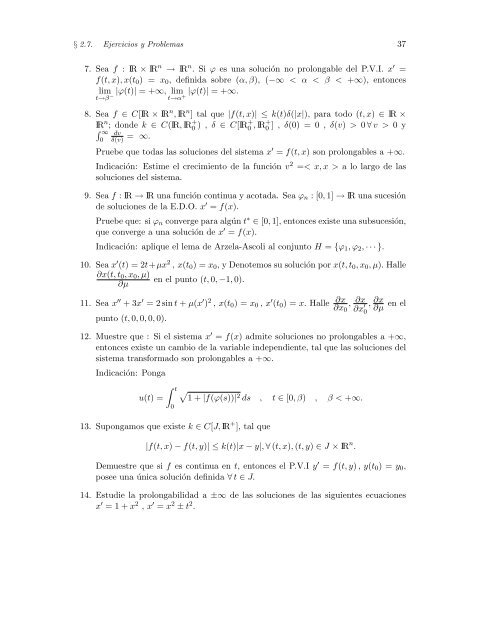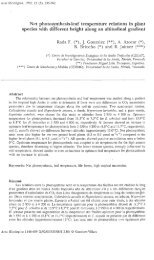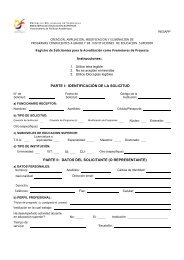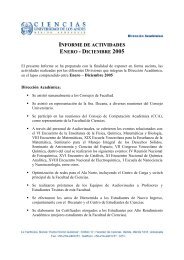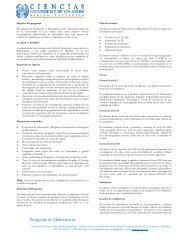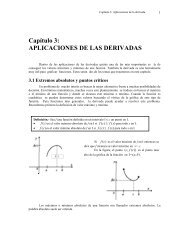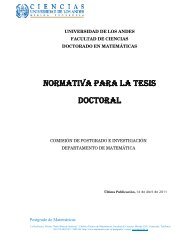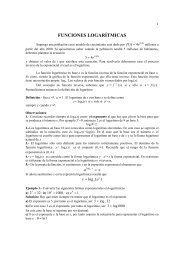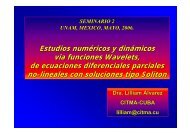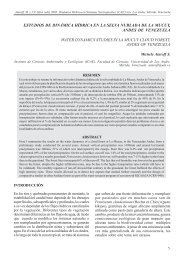Ecuaciones Diferenciales Ordinarias - Facultad de Ciencias
Ecuaciones Diferenciales Ordinarias - Facultad de Ciencias
Ecuaciones Diferenciales Ordinarias - Facultad de Ciencias
Create successful ePaper yourself
Turn your PDF publications into a flip-book with our unique Google optimized e-Paper software.
§ 2.7. Ejercicios y Problemas 37<br />
7. Sea f : IR × IR n → IR n . Si ϕ es una solución no prolongable <strong>de</strong>l P.V.I. x ′ =<br />
f(t, x), x(t 0 ) = x 0 , <strong>de</strong>finida sobre (α, β), (−∞ < α < β < +∞), entonces<br />
|ϕ(t)| = +∞, lim |ϕ(t)| = +∞.<br />
− +<br />
lim<br />
t→β<br />
t→α<br />
8. Sea f ∈ C[IR × IR n , IR n ] tal que |f(t, x)| ≤ k(t)δ(|x|), para todo (t, x) ∈ IR ×<br />
∫<br />
IR n ; don<strong>de</strong> k ∈ C(IR, IR + 0 ) , δ ∈ C[IR+ 0 , IR+ 0 ] , δ(0) = 0 , δ(v) > 0 ∀v > 0 y<br />
∞ dv<br />
0 δ(v) = ∞.<br />
Pruebe que todas las soluciones <strong>de</strong>l sistema x ′ = f(t, x) son prolongables a +∞.<br />
Indicación: Estime el crecimiento <strong>de</strong> la función v 2 =< x, x > a lo largo <strong>de</strong> las<br />
soluciones <strong>de</strong>l sistema.<br />
9. Sea f : IR → IR una función continua y acotada. Sea ϕ n : [0, 1] → IR una sucesión<br />
<strong>de</strong> soluciones <strong>de</strong> la E.D.O. x ′ = f(x).<br />
Pruebe que: si ϕ n converge para algún t ∗ ∈ [0, 1], entonces existe una subsucesión,<br />
que converge a una solución <strong>de</strong> x ′ = f(x).<br />
Indicación: aplique el lema <strong>de</strong> Arzela-Ascoli al conjunto H = {ϕ 1 , ϕ 2 , · · · }.<br />
10. Sea x ′ (t) = 2t+µx 2 , x(t 0 ) = x 0 , y Denotemos su solución por x(t, t 0 , x 0 , µ). Halle<br />
∂x(t, t 0 , x 0 , µ)<br />
en el punto (t, 0, −1, 0).<br />
∂µ<br />
11. Sea x ′′ + 3x ′ = 2 sint + µ(x ′ ) 2 , x(t 0 ) = x 0 , x ′ (t 0 ) = x. Halle<br />
∂x ∂x , ∂x<br />
0 ∂x ′ ,<br />
∂µ ∂x<br />
0<br />
punto (t, 0, 0, 0, 0).<br />
en el<br />
12. Muestre que : Si el sistema x ′ = f(x) admite soluciones no prolongables a +∞,<br />
entonces existe un cambio <strong>de</strong> la variable in<strong>de</strong>pendiente, tal que las soluciones <strong>de</strong>l<br />
sistema transformado son prolongables a +∞.<br />
Indicación: Ponga<br />
u(t) =<br />
∫ t<br />
0<br />
13. Supongamos que existe k ∈ C[J,IR + ], tal que<br />
√<br />
1 + |f(ϕ(s))| 2 ds , t ∈ [0, β) , β < +∞.<br />
|f(t, x) − f(t, y)| ≤ k(t)|x − y|, ∀(t, x), (t, y) ∈ J × IR n .<br />
Demuestre que si f es continua en t, entonces el P.V.I y ′ = f(t, y), y(t 0 ) = y 0 ,<br />
posee una única solución <strong>de</strong>finida ∀t ∈ J.<br />
14. Estudie la prolongabilidad a ±∞ <strong>de</strong> las soluciones <strong>de</strong> las siguientes ecuaciones<br />
x ′ = 1 + x 2 , x ′ = x 2 ± t 2 .


